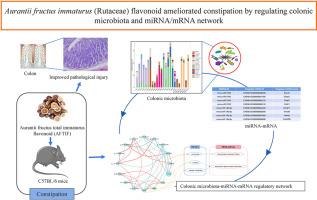牛蒡黄酮通过调节结肠微生物群和miRNA/mRNA网络改善便秘
IF 3
3区 医学
Q1 INTEGRATIVE & COMPLEMENTARY MEDICINE
Journal of Traditional and Complementary Medicine
Pub Date : 2025-09-01
DOI:10.1016/j.jtcme.2024.11.011
引用次数: 0
摘要
枳实黄酮(AFIF)是枳实(芸香科)(AFI)的主要成分,具有抗便秘作用。本研究探讨AFIF对小鼠抗生素性便秘(AC)的作用机制。将46周龄雌性C57BL/6小鼠随机分为4组(n = 10):对照组、对照组+ AFIF组、模型组和模型+ AFIF组。混合抗生素建立AC模型,培养8 d。每天给小鼠灌胃AFIF (0.1 mL/10 g、3 g/mL),持续2周。采用苏木精和伊红(H&;E)染色和周期性酸席夫(PAS)染色进行组织学分析。通过16sRNA测序分析结肠菌群。转录组测序检测miRNA和mRNA的表达谱。结果表明,AFIF处理改善了AC小鼠的便秘:增加了粪便数量、粪便湿重、粪便含水量和肠推进率;降低个体粪便的平均重量。AFIF改善了结肠病理损伤,提高了乙酰胆碱(ACH)、胃泌素(GAS)、胃动素(MTL)、P物质(SP)和血管活性肠肽(VIP)水平。此外,AFIF可能通过调节结肠微生物群和与细胞连接和神经活性功能相关的“miRNA-mRNA”调节网络来改善AC。本研究还发现,属水平的结肠微生物群与mmu-miR-5100和mmu-miR-18b-5p的表达和靶mRNA表达(包括Ccdc85b、Dlgap2、Elavl4和Shisa6)有关。综上所述,AFIF可通过调节结肠菌群和“miRNA-mRNA”调控网络改善AC,为扩大其临床应用提供理论依据。本文章由计算机程序翻译,如有差异,请以英文原文为准。

Aurantii fructus immaturus (Rutaceae) flavonoid ameliorated constipation by regulating colonic microbiota and miRNA/mRNA network
Aurantii fructus immaturus flavonoid (AFIF) is the main constituent of Aurantii fructus immaturus (Rutaceae) (AFI), and is effective against constipation. This study explores the mechanism of AFIF against antibiotics-induced constipation (AC) in mice. Forty six-week-old female C57BL/6 mice were randomly divided into 4 groups (n = 10): control, control + AFIF, model, and model + AFIF groups. The AC model was established by antibiotics mixture for 8 days. Mice were gavaged daily with AFIF (0.1 mL/10 g, 3 g/mL) for 2 weeks. Hematoxylin and eosin (H&E) staining and periodic acid-Schiff (PAS) staining were used for histological analysis. The colonic microbiota was analyzed by 16sRNA sequencing. Transcriptome sequencing was used to detect miRNA and mRNA expression profiles. The results showed that AFIF treatment improved constipation in AC mice: increased fecal number, fecal wet weight, fecal water content, and intestinal propulsion rate; decreased average weight of individual feces. AFIF improved the colonic pathological injury and increased acetylcholine (ACH), gastrin (GAS), motilin (MTL), substance P (SP), and vasoactive intestinal peptide (VIP) levels. Moreover, AFIF might improve AC by regulating colonic microbiota and a “miRNA-mRNA” regulatory network related to cell junction and neuroactive function. This study also found the colonic microbiota at the genus level was connected to the expressions and target mRNA expressions (including Ccdc85b, Dlgap2, Elavl4, and Shisa6) of mmu-miR-5100 and mmu-miR-18b-5p. In conclusions, AFIF could improve AC via regulating colonic microbiota and a “miRNA-mRNA” regulatory network, which provide a theoretical basis for expanding its clinical application.
求助全文
通过发布文献求助,成功后即可免费获取论文全文。
去求助
来源期刊

Journal of Traditional and Complementary Medicine
Medicine-Complementary and Alternative Medicine
CiteScore
9.30
自引率
6.70%
发文量
78
审稿时长
66 days
期刊介绍:
eJTCM is committed to publish research providing the biological and clinical grounds for using Traditional and Complementary Medical treatments as well as studies that demonstrate the pathophysiological and molecular/biochemical bases supporting the effectiveness of such treatments. Review articles are by invitation only.
eJTCM is receiving an increasing amount of submission, and we need to adopt more stringent criteria to select the articles that can be considered for peer review. Note that eJTCM is striving to increase the quality and medical relevance of the publications.
 求助内容:
求助内容: 应助结果提醒方式:
应助结果提醒方式:


